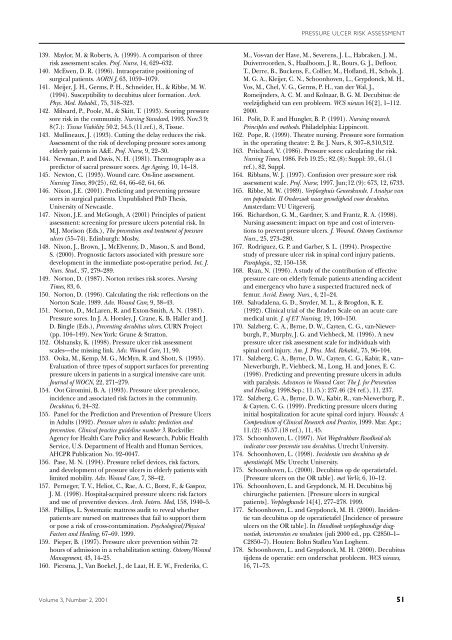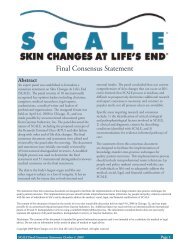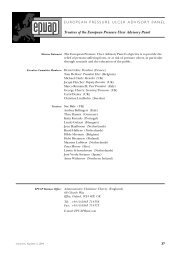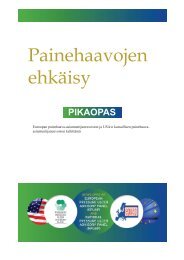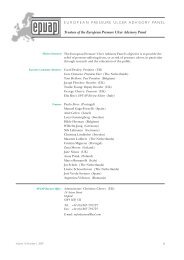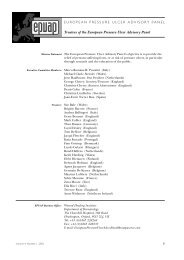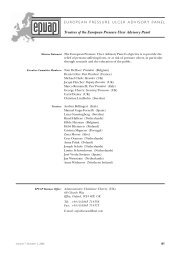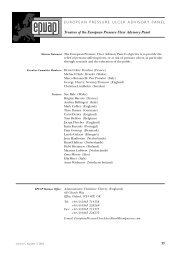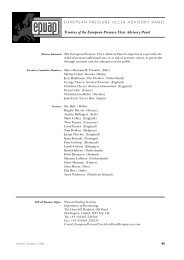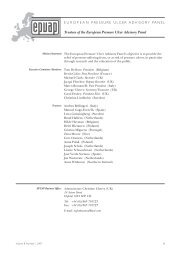Review 3.2 - European Pressure Ulcer Advisory Panel
Review 3.2 - European Pressure Ulcer Advisory Panel
Review 3.2 - European Pressure Ulcer Advisory Panel
Create successful ePaper yourself
Turn your PDF publications into a flip-book with our unique Google optimized e-Paper software.
PRESSURE ULCER RISK ASSESSMENT<br />
139. Maylor, M. & Roberts, A. (1999). A comparison of three<br />
risk assessment scales. Prof. Nurse, 14, 629–632.<br />
140. McEwen, D. R. (1996). Intraoperative positioning of<br />
surgical patients. AORN J, 63, 1059–1079.<br />
141. Meijer, J. H., Germs, P. H., Schneider, H., & Ribbe, M. W.<br />
(1994). Susceptibility to decubitus ulcer formation. Arch.<br />
Phys. Med. Rehabil., 75, 318–323.<br />
142. Milward, P., Poole, M., & Skitt, T. (1993). Scoring pressure<br />
sore risk in the community. Nursing Standard, 1993. Nov.3 9;<br />
8(7.): Tissue Viability: 50.2, 54.5.(11.ref.), 8, Tissue.<br />
143. Mullineaux, J. (1993). Cutting the delay reduces the risk.<br />
Assessment of the risk of developing pressure sores among<br />
elderly patients in A&E. Prof. Nurse, 9, 22–30.<br />
144. Newman, P. and Davis, N. H. (1981). Thermography as a<br />
predictor of sacral pressure sores. Age Ageing, 10, 14–18.<br />
145. Newton, C. (1993). Wound care. On-line assessment.<br />
Nursing Times, 89(25), 62, 64, 66–62, 64, 66.<br />
146. Nixon, J.E. (2001). Predicting and preventing pressure<br />
sores in surgical patients. Unpublished PhD Thesis,<br />
University of Newcastle.<br />
147. Nixon, J.E. and McGough, A (2001) Principles of patient<br />
assessment: screening for pressure ulcers potential risk. In<br />
M.J. Morison (Eds.), The prevention and treatment of pressure<br />
ulcers (55–74). Edinburgh: Mosby.<br />
148. Nixon, J., Brown, J., McElvenny, D., Mason, S. and Bond,<br />
S. (2000). Prognostic factors associated with pressure sore<br />
development in the immediate post-operative period. Int. J.<br />
Nurs. Stud., 37, 279–289.<br />
149. Norton, D. (1987). Norton revises risk scores. Nursing<br />
Times, 83, 6.<br />
150. Norton, D. (1996). Calculating the risk: reflections on the<br />
Norton Scale. 1989. Adv. Wound Care, 9, 38–43.<br />
151. Norton, D., McLaren, R. and Exton-Smith, A. N. (1981).<br />
<strong>Pressure</strong> sores. In J. A. Horsley, J. Crane, K. B. Haller and J.<br />
D. Bingle (Eds.), Preventing decubitus ulcers. CURN Project<br />
(pp. 104–149). New York: Grune & Stratton.<br />
152. Olshansky, K. (1998). <strong>Pressure</strong> ulcer risk assessment<br />
scales—the missing link. Adv. Wound Care, 11, 90.<br />
153. Ooka, M., Kemp, M. G., McMyn, R. and Shott, S. (1995).<br />
Evaluation of three types of support surfaces for preventing<br />
pressure ulcers in patients in a surgical intensive care unit.<br />
Journal of WOCN, 22, 271–279.<br />
154. Oot Giromini, B. A. (1993). <strong>Pressure</strong> ulcer prevalence,<br />
incidence and associated risk factors in the community.<br />
Decubitus, 6, 24–32.<br />
155. <strong>Panel</strong> for the Prediction and Prevention of <strong>Pressure</strong> <strong>Ulcer</strong>s<br />
in Adults (1992). <strong>Pressure</strong> ulcers in adults: prediction and<br />
prevention. Clinical practice guideline number 3. Rockville:<br />
Agency for Health Care Policy and Research, Public Health<br />
Service, U.S. Department of Health and Human Services,<br />
AHCPR Publication No. 92–0047.<br />
156. Pase, M. N. (1994). <strong>Pressure</strong> relief devices, risk factors,<br />
and development of pressure ulcers in elderly patients with<br />
limited mobility. Adv. Wound Care, 7, 38–42.<br />
157. Perneger, T. V., Heliot, C., Rae, A. C., Borst, F., & Gaspoz,<br />
J. M. (1998). Hospital-acquired pressure ulcers: risk factors<br />
and use of preventive devices. Arch. Intern. Med, 158, 1940–5.<br />
158. Phillips, L. Systematic mattress audit to reveal whether<br />
patients are nursed on mattresses that fail to support them<br />
or pose a risk of cross-contamination. Psychological/Physical<br />
Factors and Healing, 67–69. 1999.<br />
159. Pieper, B. (1997). <strong>Pressure</strong> ulcer prevention within 72<br />
hours of admission in a rehabilitation setting. Ostomy/Wound<br />
Management, 43, 14–25.<br />
160. Piersma, J., Van Boekel, J., de Laat, H. E. W., Frederiks, C.<br />
M., Vos-van der Have, M., Severens, J. L., Habraken, J. M.,<br />
Duivenvoorden, S., Haalboom, J. R., Bours, G. J., Defloor,<br />
T., Derre, B., Buckens, F., Collier, M., Hofland, H., Schols, J.<br />
M. G. A., Kleijer, C. N., Schoonhoven, L., Grypdonck, M. H.,<br />
Vos, M., Chel, V. G., Germs, P. H., van der Wal, J.,<br />
Romeijnders, A. C. M. and Kolnaar, B. G. M. Decubitus: de<br />
veelzijdigheid van een probleem. WCS nieuws 16[2], 1–112.<br />
2000.<br />
161. Polit, D. F. and Hungler, B. P. (1991). Nursing research.<br />
Principles and methods. Philadelphia: Lippincott.<br />
162. Pope, R. (1999). Theatre nursing. <strong>Pressure</strong> sore formation<br />
in the operating theatre: 2. Br. J. Nurs, 8, 307–8,310,312.<br />
163. Pritchard, V. (1986). <strong>Pressure</strong> sores: calculating the risk.<br />
Nursing Times, 1986. Feb 19.25.; 82.(8): Suppl: 59., 61.(1<br />
ref.), 82, Suppl.<br />
164. Ribbans, W. J. (1997). Confusion over pressure sore risk<br />
assessment scale. Prof. Nurse, 1997. Jun;12.(9): 673, 12, 6733.<br />
165. Ribbe, M. W. (1989). Verpleeghuis Geneeskunde. I Analyse van<br />
een populatie. II Onderzoek naar gevoeligheid voor decubitus.<br />
Amsterdam: VU Uitgeverij.<br />
166. Richardson, G. M., Gardner, S. and Frantz, R. A. (1998).<br />
Nursing assessment: impact on type and cost of interventions<br />
to prevent pressure ulcers. J. Wound. Ostomy Continence<br />
Nurs., 25, 273–280.<br />
167. Rodriguez, G. P. and Garber, S. L. (1994). Prospective<br />
study of pressure ulcer risk in spinal cord injury patients.<br />
Paraplegia., 32, 150–158.<br />
168. Ryan, N. (1996). A study of the contribution of effective<br />
pressure care on elderly female patients attending accident<br />
and emergency who have a suspected fractured neck of<br />
femur. Accid. Emerg. Nurs., 4, 21–24.<br />
169. Salvadalena, G. D., Snyder, M. L., & Brogdon, K. E.<br />
(1992). Clinical trial of the Braden Scale on an acute care<br />
medical unit. J. of ET Nursing, 19, 160–150.<br />
170. Salzberg, C. A., Byrne, D. W., Cayten, C. G., van-Niewerburgh,<br />
P., Murphy, J. G. and Viehbeck, M. (1996). A new<br />
pressure ulcer risk assessment scale for individuals with<br />
spinal cord injury. Am. J. Phys. Med. Rehabil., 75, 96–104.<br />
171. Salzberg, C. A., Byrne, D. W., Cayten, C. G., Kabir, R., van–<br />
Niewerburgh, P., Viehbeck, M., Long, H. and Jones, E. C.<br />
(1998). Predicting and preventing pressure ulcers in adults<br />
with paralysis. Advances in Wound Care: The J. for Prevention<br />
and Healing, 1998.Sep.; 11.(5.): 237.46 (24 ref.), 11, 237.<br />
172. Salzberg, C. A., Byrne, D. W., Kabir, R., van-Niewerburg, P.,<br />
& Cayten, C. G. (1999). Predicting pressure ulcers during<br />
initial hospitalization for acute spinal cord injury. Wounds: A<br />
Compendium of Clinical Research and Practice, 1999. Mar. Apr.;<br />
11.(2): 45.57.(18 ref.), 11, 45.<br />
173. Schoonhoven, L. (1997). Niet Wegdrukbare Roodheid als<br />
indicator voor preventie van decubitus. Utrecht University.<br />
174. Schoonhoven, L. (1998). Incidentie van decubitus op de<br />
operatietafel. MSc Utrecht University.<br />
175. Schoonhoven, L. (2000). Decubitus op de operatietafel.<br />
[<strong>Pressure</strong> ulcers on the OR table]. met VerVe, 6, 10–12.<br />
176. Schoonhoven, L. and Grypdonck, M. H. Decubitus bij<br />
chirurgische patienten. [<strong>Pressure</strong> ulcers in surgical<br />
patients]. Verpleegkunde 14[4], 277–278. 1999.<br />
177. Schoonhoven, L. and Grypdonck, M. H. (2000). Incidentie<br />
van decubitus op de operatietafel [Incidence of pressure<br />
ulcers on the OR table]. In Handboek verpleegkundige diagnostiek,<br />
interventies en resultaten (juli 2000 ed., pp. C2850–1–<br />
C2850–7). Houten: Bohn Stafleu Van Loghem.<br />
178. Schoonhoven, L. and Grypdonck, M. H. (2000). Decubitus<br />
tijdens de operatie: een onderschat probleem. WCS nieuws,<br />
16, 71–73.<br />
Volume 3, Number 2, 2001 51


